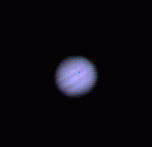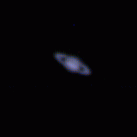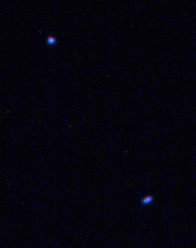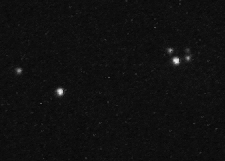
This was my first shot at prime focus. Unlike the shot through the eyepiece (see my first imaging session for a link to Jupiter's image), this one shows four bands. It also shows some detail in the NEB (north is up in this picture): two spikes pointing equatorward, as I've noted a couple of times in the log.
To be more honest, it wasn't quite my first shot—it was my third. But the first nine were all of Jupiter; the third just happened to be the best out of the nine. A common tactic.

Saturn is smaller and much more difficult to extract detail out of, despite its spectacular rings. Again, north is up. You can just barely make out that the rings cross in front on the top side of this image, and cross in back on the bottom side. The whiter equatorial region can also just be contrasted with the darker temperate zone.

One of the most spectacular double stars in the night sky is beta Cygni, better known as Albireo. It's a pairing of a second magnitude yellow star with a fourth magnitude blue one. The blue secondary can be seen quite well in this image.

I included this shot of epsilon Lyrae, the Double Double, because of some conceit I have that you can actually make out the direction of the secondaries. Obviously the individual doubles aren't resolved, but you can see some elongation which I believe is a real feature, and not just some jiggling of the scope. This image has been blue-enhanced to bring out what little split there is. At some point I should probably try to grab Struve 2470/2474, which is an easier pair and quite nice. (And also in Lyra.)

Another common celestial rest stop is M42, the Orion Nebula. From my site, M42 is actually a subtle puff of smoke, not at all the magnificent O'Keefian splendor you see in coffee table books, but the Trapezium, the quadruplet of stars at the heart of M42, stands out quite well. (The Trapezium (theta1 Orionis) is actually a small cluster that includes at least five or six other stars within the range of reasonably sized amateur scopes.) Here we see the four main stars of the Trapezium, as well as the two wider stars of theta2 Orionis.
Copyright (c) 1998 Brian Tung